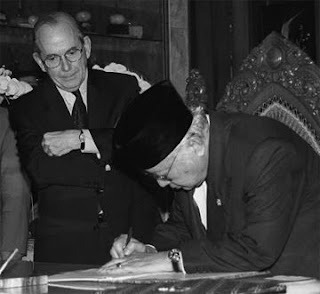
Seorang jenderal dalam usia 46 mulai menggenggam kekuasaan yang besar. Sejarah sudah membahasnya, dan bahasan itu belum usai. Anda boleh kagum sepenuh takzim, boleh pula benci kepadanya — atau seperti banyak orang bingung untuk merumuskannya dalam satu kata. Meski saya sangat tidak suka kepadanya — ketika dia hidup, saya selalu menyebutnya dalam blog sebagai “orang itu” — saya mengakui bahwa dalam dirinya pasti ada hal-hal baik bahkan mulia. Dia manusia, bukan iblis, bukan malaikat.
Saya teringat dia karena barusan menemukan foto-foto lama yang dulu, sudah lama banget, pernah saya lihat di majalah Life. Foto-foto yang sebagian adalah hasil pengarahan dan mengundang tafsir subyektif itu. Di kemudian hari, pada puncak kekuasaannya, siapa yang bisa membuat dia nyaman dan rileks untuk diatur-atur, dan difoto dari dekat?
Dari jepratan Larry Burrows, pewarta foto perang itu, saya melihat foto-foto penuh percaya diri seorang jenderal yang nyaman menggenggam cek kosong sejak awal kekuasaannya, hampir boleh ngapain aja, karena banyak orang percaya dan berharap kepadanya.
Foto-foto itu menggambarkan kepercayaan diri yang tinggi tanpa menjadi congkak berlebihan, karena dari seorang Jawa introvert, yang bercitra humble, selalu ada cara lunak untuk menunjukkan kelebihan diri. Mampu mengemas keangkuhan dalam kehalusan.
Saya melihat foto-foto seorang suami dan ayah yang hangat. Barangkali, karena kultur kita, maka dia pun menganggap rakyat sebagai anak — demikian pula rakyat terhadapnya: bapak. Selebihnya adalah father knows best dan dia menjadi patriarch, menjadi sentrum dari segala tafsir tentang kebenaran.
Dia akhirnya menjadi romo (rama, ayahanda, dalam konteks ini bukan pastor) yang bahasa tubuhnya, termasuk anggukan kecil, adalah sabda nonverbal yang siap ditafsir dan dilaksanakan. Ini seperti cerita seorang bekas menteri: jika dia meraih gelas minuman saat mendengarkan usulan maka itu berarti penolakan.
Tentang buku, catatan, dan kliping, sudah banyak yang mengumpulkan dan mengkajinya. Tetapi bagaimana dengan foto? Mestinya Sekretariat Negara, Antara, Pusat Informasi Kompas, dan Pusat Dokumentasi dan Analisa Tempo punya ribuan foto yang siap ditafsir. Saya tak tahu apakah TVRI menyimpan dokumentasinya dengan baik.
Video TVRI dan foto koran menampilkan hal yang tampaknya sederhana dari pidato ke pidato: kacamata dan arloji sang jenderal yang sering berganti. Maka orang awam membatin, “Gimana ya caranya beli? Kan nggak mungkin jalan-jalan ke toko?”
Kumpulan video TVRI pasti menampilkan seremoni yang layak tafsir. Tentang seorang raja yang dari periode ke periode berdiri semangkin dingin, menyambut antrean daripada tetamu yang akan berjabat tangan. Jarak yang tak bergaris antara dia dan tetamu menghadirkan pemandangan sama: tetamu harus membungkuk. Mirip saya menyalami orang-orang (tua).
Demikian pula foto-foto hadirin dalam banyak acara kepresidenen, yang karena tuntutan protokoler harus ngapurancang (mempertemukan tangan di depan atau bawah perut). Sopan sekaligus aman. Mempermudah pekerjaan paswalpres dalam mengawasi.
Itulah sebabnya foto Direktur Pelaksana IMF Michael Camdesus bersedekap ketika menyaksikan presiden menandatangani kesepakatan pada 15 Januari 1998. Adegan itu, seperti sebuah kapitulasi atau penyerahan diri seorang pemimpin — bahasa kasarnya: pengakuan keok.
Ada yang tersinggung, ada yang bersorak, terhadap foto itu. Alasan Camdessus di kemudian hari sangat menarik. Dia mengikuti ajaran ibunya, yaitu kalau sedang kikuk karena tidak tahu harus berbuat apa ya lipatlah tangan.
Foto-foto selalu menarik. Mirip kita mengamati foto kawan di Facebook. Maka ketika koran-koran mulai dicetak berwarna, rakyat pun sadar akan satu hal: pesawat telepon di meja kerjanya, di Bina Graha, ternyata berlapis emas.
Foto lain yang tak ada urusannya dengan warna adalah sepasang gading gajah di salah satu ruang rumahnya, Jalan Cendana. Ada rak hiasan di sana. Orang yang belum pernah ke sana akan menebak, tak adakah jendela di ruang itu?Foto resmi kepresidenen edisi 1993, di Wikipedia Indonesia, menampilkan sosok yang berjarak, tak tersentuh. Rambut yang tak tertutup peci tampak memutih. Dalam usia 72 dia masih tampak gagah. Bandingkan empat tahun kemudian, akhir 1997, ketika krisis moneter mulai menghimpit Indonesia. Dia tampak menua sekali dan lelah. Makin banyak yang bersifat kritis terhadapnya, dan mulai terasa pembiaran oleh pihak tertentu terhadap arus yang menentang dan menantangnya.
Foto resmi kepresidenan adalah sebuah kewajaran di negeri mana pun. Menjadi aneh ketika makin banyak orang tak menyukainya, sehingga seorang seorang guru yang mengajar di alma maternya pun menyesal ketika harus bertemu wajah kepala negara yang sama tetapi berbeda edisi. Foto orang yang dia lihat saat dulu bersekolah.
Dan lihatlah, alangkah banyaknya foto mempelai di gedung resepsi yang gebyok atau backdrop pelaminannya tidak bisa menutupi foto presiden dan wakilnya. Seolah kemarin dan hari ini adalah sama saja. Padahal dari waktu ke waktu potret sang presiden berubah. Kesukaan maupun ketidaksukaan kita menghasilkan kesamaan: kebosanan untuk mengamati lebih jauh.
Itulah foto kepresiden yang secara berlebihan dianggap sebagai faktor penambah penduduk Indonesia. Jumlah mutakhir penduduk adalah data terakhir dari pemerintah plus foto presiden (karena saking banyaknya dan terus bertambah). Ngawur tapi menghibur.
Dia adalah tokoh. Penting pula. Tak mungkin terlupakan. Video awal 80-an sampai pertengahan 90-an menampakkan seorang penguasa yang tak terbantahkan. Ingat bagaimana dia menyatakan akan menggebuk kaum dissident? Tidak meledak, ada senyum dan menahan tawa, tetapi dingin. Semburat kebengisan tergambar di sana.
Dia memang bukan Castro atau Ghaddafi yang kuat mengoceh, tetapi dalam gaya kebapakan dia tetap tak terbantahkan, terutama dalam pidato tanpa teks dan tanya-jawab. Dehemnya sebelum berkata-kata pun punya kekuatan. Inilah era monolog Butet Kertaradjasa dalam menirukan vokal maupun gesturnya menjadi katup pelepas orang-orang tertindas.
Ingatan kita tentang seseorang seringkali berupa gambar di benak. Visual sifatnya. Ingatan apa yang ada di benak Anda tentang dia? Foto resmi itu? Prangko? Atau foto yang lain?
Mari kita tunggu sebuah hasil riset foto terhadap potret Soeharto — ya, dialah yang saya maksud sejak tadi — lengkap dengan tafsiran subyektifnya. Termasuk foto-foto yang humane tentang dia. Tentu kita juga harus kritis bahwa foto tunggal, satu versi pula, hanyalah hasil pembekuan sebuah peristiwa. Tanpa memahami konteks kita bisa tergelincir dalam menafsir.
Entahlah siapa yang akan melakukan riset foto. Harapan saya sih Anda. :)
(dikutip dari Blogombal paman Tyo)
© Foto-foto lama: Larry Burrows/Life, Desember 1967
© Foto Soeharto main gitar: entah
© Foto Camdessus dan Soeharto : entah











